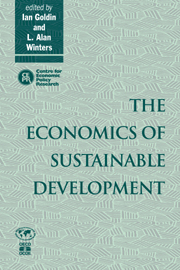Book contents
- Frontmatter
- Contents
- List of figures
- List of tables
- Preface
- Acknowledgements
- List of conference participants
- 1 Economic policies for sustainable development
- PART ONE GROWTH AND THE ENVIRONMENT
- PART TWO SUSTAINABILITY
- PART THREE DOMESTIC POLICY
- PART FOUR INTERNATIONAL POLICY COORDINATION
- 9 Carbon abatement, transfers and energy efficiency
- 10 Policy coordination for sustainability: commitments, transfers, and linked negotiations
- Discussion
- 11 Industrial competitiveness, environmental regulation and direct foreign investment
- Discussion
- Index
10 - Policy coordination for sustainability: commitments, transfers, and linked negotiations
Published online by Cambridge University Press: 04 August 2010
- Frontmatter
- Contents
- List of figures
- List of tables
- Preface
- Acknowledgements
- List of conference participants
- 1 Economic policies for sustainable development
- PART ONE GROWTH AND THE ENVIRONMENT
- PART TWO SUSTAINABILITY
- PART THREE DOMESTIC POLICY
- PART FOUR INTERNATIONAL POLICY COORDINATION
- 9 Carbon abatement, transfers and energy efficiency
- 10 Policy coordination for sustainability: commitments, transfers, and linked negotiations
- Discussion
- 11 Industrial competitiveness, environmental regulation and direct foreign investment
- Discussion
- Index
Summary
Introduction
In a world of transnational or global pollution, the optimal protection of the environment requires an international, and sometimes a global, coordination of emission control policies. Hence, the analysis of sustainable growth, and of the related optimal environmental policy, must take into account the international dimension of the environment. Define as ‘sustainable’ a growth path which accounts for the various functions of environmental resources (in production and consumption). Even if all countries solve the intertemporal optimisation problem, and define a domestic emission path which can ensure the environmental sustainability of economic growth, the existence of transnational and global externalities leads to a suboptimal outcome through various forms of free-riding behaviour.
On the one hand, the global effects of some forms of pollution jeopardise the unilateral attempts at reducing emissions; on the other, the appropriability of a cleaner global environment by all countries provides an incentive not to join global environmental agreements, undermining the attempts at cooperation through free-riding. Hence the need for international coordination.
In principle, the required coordination of emissions could be obtained through a set of global regulations, implementing an optimal management of emissions. However, in the existing institutional setting, there is no authority which can impose supranational environmental policies, and emissions coordination has to be obtained through voluntary agreements among sovereign countries.
- Type
- Chapter
- Information
- The Economics of Sustainable Development , pp. 264 - 282Publisher: Cambridge University PressPrint publication year: 1995
- 21
- Cited by



